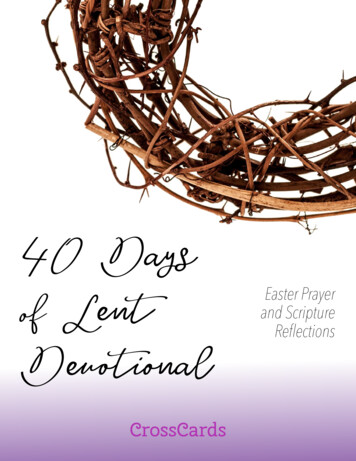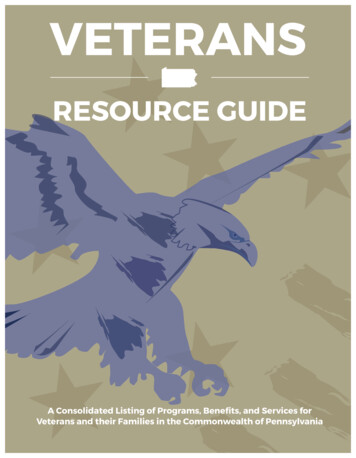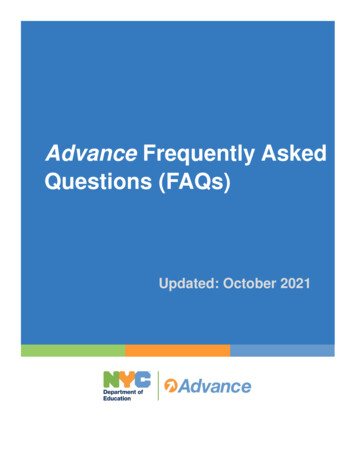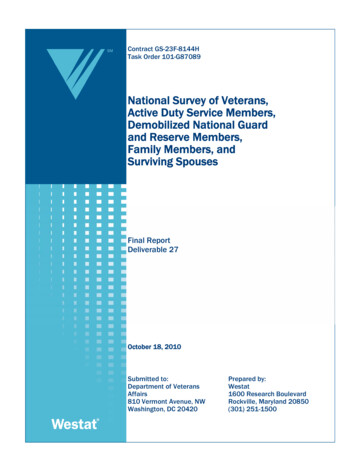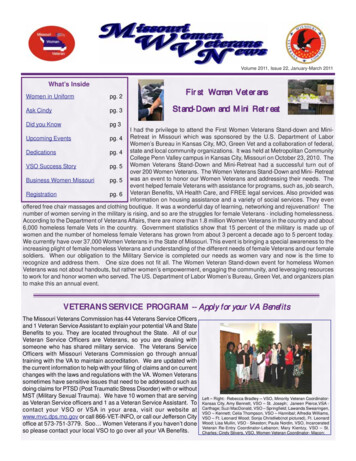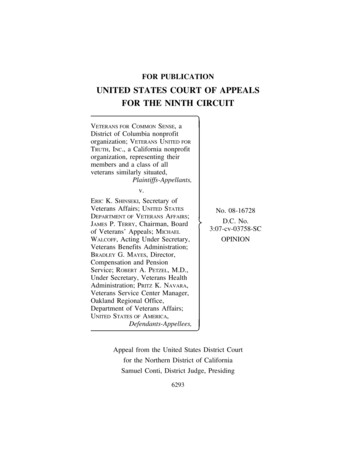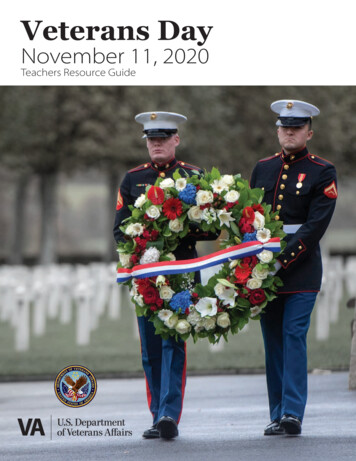
Transcription
Veterans DayNovember 11, 2020Teachers Resource Guide
2 Table of ContentsThe U.S. Department of Veterans Affairs and the Veterans Day National Committee are pleased toprovide you with this Teachers Resource Guide. It is our hope that by thanking America’s Veterans andtheir families for their service and sacrifice, we can reward them with the honor they so richly deserve.Introduction.page 3Program Guide.page 4Tomb of the Unknown Soldier.page 5Prisoners of War (POWs) and Those Missing in Action (MIAs).page 6Origins of Veterans Day.page 7Student Activities.page 8Veterans Legacy Program.page 9America’s Wars.page 10How to Contact Veterans Service Organizations.page 11Scholarships.page 12Respecting the Flag.page 13Folding the Flag.page 142020 Veterans Day National Committee.page 16Each year, the Veterans Day National Committee publishes acommemorative Veterans Day poster. The poster is selected fromartwork submitted by artists nationwide and is distributed to VAfacilities across the country and to military installations around theworld. It also serves as the cover of the official program for theVeterans Day Observance at Arlington National Cemetery.Over the years, these posters have illustrated the rich history ofour country’s service members. Each poster clearly reflects our prideand patriotism in saluting Veterans while providing thematic artistryfor the year.Current and past Veterans Day posters are available for downloadfrom VA’s Veterans Day Poster Gallery athttps://www.va.gov/opa/vetsday/gallery.asp.On the CoverNovember 2018: U.S. Marines carry a wreath during a Veterans Day ceremony at the Aisne-Marne AmericanCemetery and Memorial near the Belleau Wood battle site in France. The battle raged throughout the monthof June 1918; when it was over, our troops had suffered nearly 10,000 casualties. It was during the Battle ofBelleau Wood, as other Allied troops were in retreat, that a U.S. Marine Corps officer spoke the now-famous retort:“Retreat? Hell, we just got here!” (Photo by Dominique A. Pineiro, U.S. Navy)Our American VeteranA Veteran of the United States is someone who has served on active duty in the Armed Forces, Public HealthService, National Oceanic and Atmospheric Administration or Environmental Science Service. The Veteran musthave earned any character of discharge other than dishonorable. On Veterans Day, we honor the service andsacrifice of all Veterans – living and deceased.Department of Veterans Affairs
WIntroduction 3elcome to the U.S. Department of Veterans Affairs 2020 VeteransDay School and Teachers Resource Guide. As Veterans Dayapproaches, we hope you will help your students connect withVeterans who served in the past, as well as service members now on activeduty. We can all better-appreciate the freedoms we have because of themen and women who have served in defense of the United States.There are about 18 million Veterans living amongInviting Local Veterans Groups:us, in every state and territory and from every walkof life. Many of the students in your class may be theson, daughter, cousin, or other relative of a Veteran orcurrent Servicemember. By engaging in discussionabout these crucial members of our society, yourstudents will be able to hear from and about thosewho helped shape U.S. history. Our hope is thatstudents will be encouraged to learn more of theseoften unheard stories from those close to them.This resource guide, along with another group ofAmerica’s finest — our teachers — will allow yourstudents to learn more about the price our braveVeterans have paid to defend our nation.The School Assembly:Because the weather can be quite cold inNovember in many parts of the country, an indoorassembly is far more sensible than one that wouldtake place outside, eliminating the need for foulweather plans.The scope of such a program may be large enoughto permit invitations to the community, to includelocal Veterans groups. Students can beencouraged to bring family memberswho are Veterans (especially parents,siblings or grandparents) or whocurrently serve in the Uniformed Service.Inviting local Veterans groups makes assemblyprograms far more exciting and meaningful forstudents. Students tend to better understand andabsorb the significance of Veterans Day when theycan attach a human face to it.In addition, Veterans groups often put on veryexciting shows. From stirring renditions of theNational Anthem to thrilling speeches and stories,Veterans will both entertain and educate students.You can find Veterans groups in your areathrough your local Veterans Service Organizations(VSOs) and Department of Veterans Affairs (VA)medical facilities or regional offices. You may besurprised at how many Veterans live in your area.Schools that send out invitations often end upwith former generals and admirals, Medal of Honorrecipients and other distinguished Veterans asguest speakers. A listing of VSOs appears on page11 of this guide. Or visit www.va.gov/vso/ for anonline directory of Veterans’ groups.Nearly 100 Veterans of America’s wars -- from World War II tothe Global War on Terrorism -- join cadets of the Elbert CountyComprehensive High School Junior Reserve Officer Training Programin rendering a hand salute, in honor of Veterans and our fallen heroesduring a Veterans Day commemoration. Georgia National Guard photo byCapt. William CarrawayVeterans Day 2020 - Teachers Resource Guide
4 Program GuideProgram Guide:Undoubtedly, your school will want to put on aprogram worthy of all your distinguished guests.The following are some suggestions for a sampleprogram guide that will make this Veterans Daymemorable for both students and guests:Prelude and Posting of Colors — As theaudience enters to be seated, a school or communitymusical organization may offer several appropriateselections. A procession and posting of the colors(U.S. Flag) is a stirring event. Local VSOs oftenparticipate in such programs with their impressivearray of military banners and U.S. Flags.Pledge of Allegiance to the Flag and Singingof the National Anthem — The programchairperson, school principal or student bodypresident should invite the audience to stand andjoin in reciting the Pledge of Allegiance and singingthe National Anthem.Introductory Remarks — Brief introductoryremarks set the tone for the entire program.Consider reading the President’s Veterans DayProclamation, which the White House issues inadvance and posts on the internet. For moreinformation, please visit: www.whitehouse.gov.Additional remarks and suitable quotations forspeeches can be found on the Veterans Day websitewww.va.gov/opa/vetsday/.Introduction of Guests — Introduce any specialguests, who may include local government officials,school alumni with distinguished military service,Veterans from the community who representdifferent periods of service and faculty members whoare Veterans.Principal Speaker — Your principal speakershould be invited far enough in advance to allowadequate preparation for your program.Student Essay or Reading — By includingvarious presentations by individual pupils in schoolprograms, student body participation may beincreased. Selected essays from class or school-widecompetitions may be read aloud by the authors. Thereading of a well-known patriotic address by a U.S.president or war hero is also effective. There are anumber of published musicals/narratives that canenhance your program. A student-performed shortplay or skit can be quite entertaining as well.Moment of Silence, Taps — While Veterans Dayis primarily a tribute to America’s living Veterans, itis always appropriate to recognize and rememberthose who gave their lives for our country. More thana century ago, World War I ended when an armistice– a truce – was signed at 11 a.m. on November 11,1918; thus, the saying that the war ended on the 11thhour of the 11th day of the 11th month. Although 11a.m. remains a traditional hour for remembering ourfallen heroes, a moment of silence is appropriate atany point in the program. This may be followed bythe playing of “Taps.” For more information on thehistory of Taps please visit www.tapsbugler.com.Closing — The Master of Ceremonies announces“Retire the Colors.” Accompanied by appropriatemusic, such as a John Philip Sousa march, the Colorsare paraded out of the assembly area. This concludesthe ceremony.The Meade High School JROTC Color Guard performs during a Veterans Day Assemblyheld at MacArthur Middle School, which has a “Partners In Education” program, whereServicemembers act as mentors to students. Photo by: Daniel Kucin Jr. Baltimore SunDepartment of Veterans Affairs
Tomb of the Unknown Soldier 5Tomb of the Unknown SoldierIn 1921, an American soldier – his name “knownbut to God”– was buried on a Virginia hillsideoverlooking the Potomac River and Washington,D.C. The burial site of this unknown World War Isoldier in Arlington National Cemetery becameknown as the Tomb of the Unknown Soldier. Theneoclassical, white marble sarcophagus depictsthree carved Greek figures representing Peace,Victory, and Valor. Inscribed on the back of the Tombare the words:“Here rests in honored glory an Americansoldier known but to God.”The Tomb sarcophagus stands above the grave ofthe Unknown Soldier of World War I. To the west arethe crypts for an Unknown Soldier from World War IIand the Korean War. A white marble slab flush withthe plaza marks each crypt.In the following years, thousands of peopleflocked to Arlington National Cemetery to paytheir respects at the Tomb of the Unknown Soldier,which soon came to symbolize the sacrifices of allAmerican Servicemembers.In 1926, Congress established a military guardto protect the Tomb during daylight hours. Sincemidnight on July 2, 1937, the Army has maintaineda 24-hour guard over the Tomb. Sentinels of the3rd U.S. Infantry, “The Old Guard,” assumed theseduties on April 6, 1948, maintaining a constant vigilregardless of weather conditions.Soldiers from the 3d U.S. Infantry Regiment (The Old Guard) support an Army Full Honors Wreath-Laying at the Tomb of the Unknown Soldier at Arlington National Cemetery in Virginia. (U.S.Army photo by Elizabeth Fraser)Veterans Day 2020 - Teachers Resource Guide
6 POW/MIAPrisoners of War (POWs) and Those Missing in Action (MIAs)Aprisoner of war (POW) is any personcaptured or placed in prison (interned)by a foreign or enemy power during war.In the strictest sense, it is used only for membersof the Armed Forces, but by broader definition ithas also included members of small independentgroups taking part in irregular fighting (guerrillas),civilians who openly fight against an enemy, ornoncombatants associated with a military force.Most Americans who became prisoners of war didso through no fault of their own; they were capturedwhile defending their country. Fortunately, POWshave become much less common in recent conflicts.For example, it is estimated that while more than130,000 were captured and interned during WorldWar II, the number fell to 725 during the VietnamWar, 47 during the Gulf War and 12 during morerecent conflicts.NameGRAND TOTALWorld War IWorld War IIKorean WarVietnam WarWe must never forget any POW or those Missingin Action (MIA) who did not return home. The issueof accounting for U.S. POW/MIAs became a matterof public interest with the founding of The NationalLeague of POW/MIA Families in 1970, formed bythe families of those missing in action during theVietnam War. The League pushed for an increasedeffort by the U.S. government to seek answers aboutthose still missing. While the Vietnam War ragedon, those at home raised awareness of the POW/MIAcause.To further show support for those who aremissing in action, National POW/MIA RecognitionDay was established in 1979 with bipartisan actionby Congress, followed by a proclamation signed byPresident Jimmy Carter. Since then, each presidenthas issued an annual proclamation for National POW/MIA Recognition Day, which falls on the third Fridayin September.Captured andInternedDied While POWReturned to U.S.Military ControlRefused to d States Army Colonel Floyd “Jim” Thompson (right),was the longest-held prisoner of war in American history,surviving nine years (3,278 days) of torture and deprivationat the hands of the enemy. While flying in an observationplane, Thompson was shot down by enemy small arms fireand was captured near Quang Tri, South Vietnam. He wasreleased with other POWs in mid-March 1973 as part ofOperation Homecoming. Photo courtesy Department of DefenseDepartment of Veterans Affairs
Origins of Veterans Day 7Origins of Veterans Day“To Honor Veterans of All Wars”Raymond Weeks of Birmingham, Alabamaorganized an Armistice Day parade for thatcity on November 11, 1947 to honor Veteransfor their loyal service. Later, U.S. RepresentativeEdward H. Rees of Kansas proposed legislationchanging the name of Armistice Day to Veterans Day– to honor all Veterans who have served America.In 1954, President Dwight D. Eisenhower signed abill proclaiming November 11th as Veterans Day andcalled upon Americans everywhere to re-dedicatethemselves to the cause of peace. He issued apresidential order directing the head of the VeteransAdministration (now the Department of VeteransAffairs) to form a Veterans Day National Committeeto organize and oversee the national observance ofVeterans Day. In addition to fulfilling that mission,the committee oversees the annual production anddistribution of a Veterans Day poster and a TeachersResource Guide.In 1968, Congress moved Veterans Day to thefourth Monday in October. However, it becameapparent that the November 11th date – the end ofWorld War I – was historically significant to manyAmericans. As a result, Congress formally returnedthe observance of Veterans Day to its traditional datein 1978.The Veterans Day National Ceremony is heldeach year on November 11th at Arlington NationalCemetery. At 11 a.m., a color guard made up ofmembers from each branch of the military rendershonors to America’s war dead during a tradition-richceremony at the Tomb of the Unknown Soldier.The President or his representative places a wreathat the Tomb and a bugler sounds “Taps.” The balanceof the ceremony, including a “Parade of Flags” bynumerous VSOs, takes place inside the MemorialAmphitheater, adjacent to the Tomb.In addition to planning and coordinating theNational Veterans Day Ceremony, the Veterans DayNational Committee supports a number of VeteransDay Regional Sites. These sites conduct VeteransDay celebrations that provide excellent examples forother communities to follow.President Dwight D. Eisenhower signs H.R.7786 into law on June 1, 1954, changing Armistice Day to Veterans Day.Veterans Day 2020 - Teachers Resource Guide
8 ActivitiesStudent Activities: Veterans Day 2020Plan a school assembly to be held on VeteransDay and invite local Veterans. Present them with asmall flag, flag pins, a medal, a traditional “poppy”or other remembrance and honor them duringthe program. [Poppies first became a symbol ofremembrance for soldiers who died during WorldWar I, since poppy fields grew where some of thebattles were fought.]Hold a Veterans Day Breakfast for teachers andstaff who are Veterans, or for local Veterans inthe area.Involve Scout groups to present the U.S. Flag andState Flag at an assembly on Veterans Day, or at themorning flag raising.Challenge students to match military terms (i.e.,“junior officer”) to a random list of definitions.Discuss the meaning of what it means to be aVeteran. Create a short play with several studentsin conversation, talking about “Who Is A Veteran?”Ask students to bring a photograph of any familymembers who are Veterans and display them. Eachphoto could be displayed on a laminated sheetof paper with the Veteran’s service record, nameand the student’s name. These photos should bemounted on school walls in a significant area.Look up former students who are Veterans anddisplay their pictures as described above, butincorporate the school colors, either as backgroundor in a ribbon, attached to the picture.Students can share the stories of their familymembers who are Veterans, and whether it wasdifficult to obtain a photograph and service records.Involve the student government by asking them toresearch teachers and staff at the school who areVeterans. Honor them with something ontheir class or office door, such as a patrioticwreath or sign made by the art class.Hold a Veterans Day Poster Contest or copy aprevious Veterans Day Poster or the current oneand paint or color it. This could be blown up verylarge or create small ones to be colored.Read the poem “In Flanders Fields” by John McCrae.Discuss the poem’s significance to Veterans. Havestudents write a poem for Veterans Day and hold acontest for the best poems. These could be read atthe school assembly or Veterans Day program.Draw pictures of poppies. Ask a local VSO for asupply of small poppies to distribute amongthe students.Write letters to Veterans and place small U.S. Flagsat the graves of local Veterans.Research Armistice Day and why it was changed toVeterans Day. Research military campaign medalsand ribbons.Assign small groups to research wars and conflicts,and give oral reports to the class.Set up a Missing Man Table during your assemblyor Veterans Day eventThe Missing Man Table is on permanent display in many military diningfacilities, and is also traditionally part of formal dinner ceremonies andmilitary balls. The ceremony may also be performed in conjunction withVeterans Day, Memorial Day and Armed Forces Day services. The MissingMan Table is a small table set for one, symbolizing the isolation of theabsent service member. (Sometimes the table is set for six – for the fivebranches of the Armed Forces and civilians.) It is meant to honor andremember those who have served and are still missing and unaccountedfor in overseas locations.Department of Veterans Affairs
Text here 9National Cemetery AdministrationVeterans Legacy ProgramDiscover Their Story – Honor Their SacrificeA National LegacyAt VA, we seek to engage educators, students, researchers,and the general public to build an appreciation of what earliergenerations have given to the nation and help us understandwhy this ground is set aside as “national shrines to the gallantdead.”The Veterans Legacy Program proudly shares the stories ofall Americans who served.TEACH USING VA NATIONAL CEMETERIES As you develop your curriculum for the fall, explore our fivenew digital lesson plans, Teacher-developed and standardsaligned. Lesson plans are built on primary sources, contain colorfulhand-outs and lesson extensions, and provide ideas for onsite learning! Additional lesson plans are being developed to invitelearners to explore their local history. Keep checking thewebsite. If you are interested in participating in one of NCA’sTeachers institutes, please contact us for information.Contact the Veterans Legacy ProgramVeteransLegacyProgram@va.govConnect with UsFor More Information, tools and resources visit us at ns Day 2020 - Teachers Resource Guide
10 America’s WarsAmerica’s WarsWORLD WAR I(1917 - 1918)Total Forces. 4,734,991Battle Deaths. 53,402Other Deaths in Service (Non-Theater). 63,114Wounded.204,002WORLD WAR II(1941 - 1945)Total Forces.16,112,566Battle Deaths. 291,557Other Deaths in Service (Non-Theater). 113,842Wounded.670,846KOREAN WAR(1950 - 1953)Total Forces. 5,720,000Battle Deaths. 33,739Other Deaths (in Theater).2,835Other Deaths in Service (Non-Theater). 7,672Wounded.103,284VIETNAM WAR(1955 - 1973)Total Forces. 8,744,000Battle Deaths.47,434Other Deaths (in Theater). 10,786Other Deaths in Service (Non-Theater).32,000Wounded. 303,644GULF WAR(1990 - 1991)Total Forces.2,225,000Battle Deaths. 147Other Deaths (in Theater).235Other Deaths in Service (Non-Theater).1,565Wounded.467Iraq War(2003 - 2011)Total Forces.192,000Killed.4,507Wounded. 32,292Afghanistan War(2001-present)Total Forces.775,000 Killed.2,420Wounded.19,950Department of Veterans Affairs
Veterans Service Organizations 11How to Contact Veterans Service Organizations (VSOs)Veterans service organizations (VSOs) are organized groups of Veterans who assist Veterans and theirfamilies, and support them as advocates for a variety of Veterans’ issues. Many organizations consistof members that share a common experience, such as those who served in the same military unitor period of war. The following is a list of organizations that serve on the Veterans Day National Committee.Many of these groups have chapters/posts throughout the country with Veterans who can share theirexperiences with younger generations.Voting MembersAssociate MembersAir Force Sergeants AssociationAir Force AssociationAmerican G.I. ForumAmerican Ex-Prisoners of WarAMVETSAmerican Gold Star Mothers, Inc.Army Navy Union, USAAmerican Red CrossBlinded Veterans AssociationAssociation of the United States NavyCatholic War Veterans, USABlue Star Mothers of AmericaCommissioned Officers Association of theUS Public Health ServiceBowlers to Veterans LinkCongressional Medal of Honor SocietyEnlisted Association of the National GuardDisabled American VeteransGold Star Wives of America, Inc.Fleet Reserve AssociationThe Independence FundJewish War Veterans of the USAJapanese American Veterans AssociationKorean War Veterans AssociationMarine Corps Reserve AssociationLegion of Valor of the USANational Association of State Directors ofMarine Corps LeagueVeterans AffairsMilitary Chaplains Association of the USANational Association of State Veterans HomesMilitary Officers Association of AmericaNavy Seabee Veterans of AmericaMilitary Order of the Purple Heart of the USA, Inc.Reserve Organization of AmericaMilitary Order of the World WarsStudent Veterans of AmericaNon Commissioned Officers AssociationWounded Warrior ProjectParalyzed Veterans of AmericaEmeritus MembersPolish Legion of American Veterans, USAThe American LegionThe Retired Enlisted AssociationVeterans of Foreign Wars of the United StatesCoast Guard Chief Petty Officers AssociationAmerican Defenders of Bataan & CorregidorMemorial SocietyWomen’s Army Corps Veterans AssociationVietnam Veterans of AmericaVeterans Day 2020 - Teachers Resource Guide
12 ScholarshipsScholarshipsWhether you’re looking into schools foryourself or a family member, you can findthe financial support and resources youneed. Here is a partial list to get you started:The Survivors & Dependents Assistance Programoffers financial assistance to children, ages 16 to 26,of U.S. Army personnel who have been disabledor killed in the line of duty. The program is alsoopen to the children of service members whohave been declared missing in action, or who havebeen detained as prisoners of war. The programoffers up to 45 months of educational benefits toeligible students who are enrolled in approvedundergraduate, graduate or vocational rdependent assistance.aspThe Spouse Education Assistance Program (SEAP)provides grant money to the eligible spousesof active-duty or retired U.S. Army personnel.Applicants must be enrolled at least part-time in anaccredited college or university. Scholarship fundingis available for fall and spring semesters only. am(SEAP)-ScholarshipThe General Henry H. Arnold Education GrantProgram. The program provides financial assistanceto the children of active-duty and retired U.S. AirForce personnel. It also provides grants for thechildren and spouses of deceased service members.This is a need-based grant and current awards standat 2,000. rant/The Navy-Marine Corps Relief Society providesfinancial support to U.S. Navy and Marine Corpspersonnel and their families. In addition to a numberof interest-free loans for service members and theirfamilies, the Relief Society offers the followingprograms for the college-bound dependents of Navyand Marine Corps personnel. holarshipsThe Joseph A, McAlinden Divers Scholarship Programis available to the children or spouses of active-dutyU.S. Navy or Marine Corps divers. Students mustbe studying oceanography, ocean agriculture oraquaculture in an approved college program. Awardsrange from 500 to 3,000, and are determinedby financial need. vers-scholarship-programThe PHS Commissioned Officers Foundation for theAdvancement of Public Health offers a scholarshipprogram available to high school students sponsoredby a member in good standing of the CommissionedOfficers Association of the USPHS. The scholarshipsare funded by active-duty and retired U.S. PublicHealth service members, local branches of theassociation, and open to students who are pursuinga career that may relate to any of the Public HealthService professional categories (e.g., physician,dentist, nurse, engineer, etc.). The Scholarship for Air Force Enlisted Members’Dependent Children is supported by the Air ForceSergeants Association and the Airmen MemorialFoundation. These scholarships are available tothe dependent children of U.S. Air Force servicemembers, retirees or Veterans. Scholarship awardsare determined by academic achievement, serviceto the community, personal character and writingability. Financial need is not a consideration. Awardamounts range from 500 to 3,000. https://www.hqafsa.org/scholarships.htmlDepartment of Veterans Affairs
Respecting the Flag 13Respecting the U.S. Flag“I pledge allegiance to the flag of the United States of America and to the Republic for which itstands, one Nation under God, indivisible, with liberty and justice for all.”Important Things to RememberThe Pledge of
Nearly 100 Veterans of America's wars -- from World War II to the Global War on Terrorism -- join cadets of the Elbert County Comprehensive High School Junior Reserve Officer Training Program in rendering a hand salute, in honor of Veterans and our fallen heroes during a Veterans Day commemoration. Georgia National Guard photo by

![Welcome [dashdiet.me]](/img/17/30-day-weight-loss-journal.jpg)
